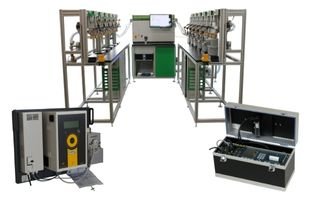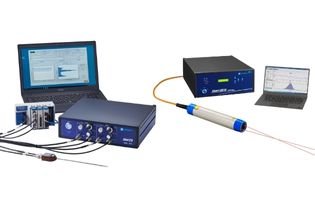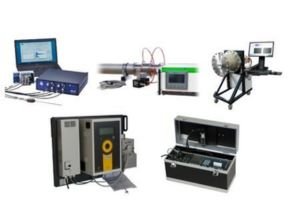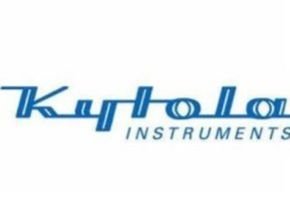About EP Flow Measurement and Calibration
EP Flow Measurement and Calibration are the leading solution provider in Germany in the field of flow (air and other gases), pressure and temperature control, leak testing and the high-precision measurement and control technology of gases (e.g. natural gas).
With over 30 years of experience, they’re your reliable partner for solutions in measurement, testing and control technology. Their work focuses on the individual customer requirement and the associated project, which we design and implement in close cooperation with you. All work steps – from project planning to commissioning – are implemented in-house. So you can be sure that you will get a result from a single source.
EP Flow Measurement and Calibration’s reliable and precise way of working can also be seen in the fact that we are one of the few companies in Germany that operate its own DAkkS laboratory (German accreditation body). In addition, we are researching new paths in measurement and test technology for gases and liquid media with partners from science and teaching, and we maintain close cooperation with the Physikalisch-Technische Bundesanstalt in Braunschweig (PTB).
The Product of EP Flow Measurement and Calibration
A test bench or measuring unit must exactly meet the requirements of your application. We, therefore, offer you tailor-made solutions for your metrological application in the areas of volume and mass flow, pressure control, the measurement of small gaseous quantities as well as high pressure and high-temperature testing. Of course, we check in advance whether an existing process can be adapted to keep the effort as low as possible. If we cannot individualize a standard solution, we will develop a new solution together with you.
Flow Measurement (For Air, Gases, and Liquid)
Their standardized measurement elements are laminar flow elements (LFE), critical nozzles, and venturi nozzles, which are combined with sensors and software from our company. This enables us to offer you complete systems that enable the output and conversion of the measured values into volume, mass, and standard volume flow.

Their measurement systems LMF® – LaminarMasterFlow®, SMF® – SonicMasterFlow®, and VMF® – VenturiMasterFlow® are used and configured as individual measurement systems or in combination with other measurement components in test benches. We can also offer you the ReciFlow ™, which is a flow meter for gases for low flows with the highest accuracy. Depending on the project, we choose the most suitable measuring element for your application. The table below gives an overview of the properties and advantages of the three measurement elements LFE, critical nozzles, and venturi nozzles.
Applications
- Calibration of flow meters e.g. gas meter, LFE, venturi nozzles, Mass Flow Meter (MFM)
- Recurring calibration tasks e.g. adjustement test benches for production parts (valves, actuators, air mass meters, etc.)
- Characteristic curve determination
- Gas conditioning
- Volume flow measurement
Specifications
| LMF® LaminarMasterFlow® | SMF® SonicMasterFlow® | VMF® VenturiMasterFlow® | |
| Measurement section | Laminar Flow Elemente | Critical nozzles (sonic nozzles) | Venturi nozzles |
| Measurement principle | Differential pressure measurement at ?p 0.1 to 25 hPa using LFE | Constant flow through critical nozzle; different flows through nozzle combination | Differential pressure measurement at ?p 1 to 500 hPa using a venturi nozzle |
| Flow range | 0.012…4000 m³/h | 0.005…10,000 m³ / h | 0.04…4000 m³/h |
| Measurement accuracy | 0.5…1 % MV | 0.2…0.3 % MV | 0.5 % MV |
| Pressure range | Atmospheric up to max. 8 bar | Atmospheric, 1000 hPa absolute up to high pressure ranges taking into account the Joule-Thomsen effects | Atmospheric up to max. 500 bar |
| Medium | Air, other gases on request | Air, natural gas, other gases on request | Air, steam, other gases on request |
| Temperature range | 0 up to 50 °C | Preferably at ambient temperature (20 to 30 °C) | Also suitable for higher temperatures |
| Key Benefit | Large measurement range of up to 1:100 by direct correlation between pressure drop and flow | High measurement accuracy and high long-term stability | Also suitable for extreme conditions (high temperatures, gases with dirt particles,…) |
Gas measuring & monitoring for gases (e.g. natural gas, nitrogen, hydrogen)
Regardless of whether recording, controlling, or measuring – in the field of gas measurement technology you will find a wide variety of test benches and systems that we have optimized for the field of measurement technology in the field of natural gas and hydrogen.

This includes reference gas meters for low-flow measurements, calibration test benches for gas meters in the areas of end-of-line, development, or endurance testing, and closed-loop or HPPP systems for the overpressure calibration of gas meters. Further details are shown in the table below. In addition, we show two other systems here – the GasPro mobile gas sampler for representative gas sampling to determine the gas quality in the gas network and a Wobbe Control System, a natural gas supply station with a control system for constant calorific value. Our flow measurement technology is therefore specifically tailored to gas technology.
Applications
- Calibration of gas meters: diaphragm gas meters, ultrasonic meters, thermoelectric gas meters
- Low-flow measurement
- Overpressure calibration
- Determination of natural gas quality
- End of Line (EoL) and an endurance test
Specifications
Reference gas meter | GMC gas meter calibration | Development/endurance test benches | Closed Loop test bench | HPPP – High-Pressure Piston Prover | |
| Pressure range | Atmospheric up to 6 bar | Atmospheric | Atmospheric | Overpressure up to 100 bar | 15 to 100 bar overpressure |
| Medium | Air, other gases on request | Air, other gases on request | Natural gas, other gases on request | Air, natural gas, other gases on request | Natural gas |
| Measurement section | Rotary piston gas meter | Critical nozzles | Critical nozzles, orifice plates, gas meters and others | Gas meter | Piston in pipe section |
| Measurement principle | Direct displacement principle with two opposing pistons | Constant flow through critical nozzle; different flows through nozzle combination | Depending on the application | Evaluation of the reference according to the state of the art | Passive, by a driven piston (driven by the gas flow) in a honed tube |
| Flow range | 0.01…16 m³/h | 0.016…160 m³/h | 0.04…16 m³/h, 0.8…25 m³/h, others on request | 1…1600 m³/h, larger ranges on request | 8…480 m³/h |
| Measurement accuracy | 0.5 % MV | 0.2…0.3 % MV | Depending on the measuring principle | Depending on the flow | Up to 0.07 % MV |
| Temperature range | 10…40 °C | 10…40 °C | 0…50°C | 10…40 °C | 18…25 °C |
| Key Benefits | Continuous and absolutely pulsation-free measurement of low-flow using a reference gas meter | User-friendly end-of-line testing of domestic gas meters | Endurance and development tests of gas meters with natural gas (ATEX compliant) | Overpressure calibration of flowmeters | Lowest measurement uncertainty with overpressure calibration of natural gas |
Flow Velocity Measurement (for air and other gases)
In the area of ??flow velocity measurement for air and gases, EPE offers both its own systems and systems from our Japanese partner Kanomax. EPE offers wind tunnels in various flow areas and designs (Eiffel Canal or Göttingen Canal). If necessary, the wind tunnels can be conditioned (pressure, temperature, humidity, CO2 content). As a rule, wind tunnels are used to calibrate wind flow velocity meters or for aerodynamic measurements on models.

In the field of speed measurement, we were able to win with our Japanese partner Kanomax a traditional manufacturer that has decades of experience in the field of flow velocity measurement. We offer the Smart LDV systems (Laser Doppler Velocity measurement) for contactless determination of the absolute velocity at different measuring points, hot wire anemometer for frequency measurement or determination of the turbulence intensity of air flows and multi-channel anemometer for determination of the average velocity of air flows. With the Amenity Manikin, the comfort, e.g. be determined in the car or in air-conditioned rooms.
- Wind tunnel (EP)
- Smart LDV (Kanomax)
- Hot-Wire Anemometer (Kanomax)
- Multi-Channel Anemometer (Kanomax)
- Amenity Manikin (Kanomax)
Applications
- Calibration of flow velocity meters
- Aerodynamic measurements on models/simulation of flow profiles on models
- Velocity measurement on components that are difficult to access or in extreme conditions (aggressive media or high temperatures)
- Performance tests and optimization of all types of fans
- Determination of the feeling of comfort, e.g. in the car or in air-conditioned rooms
Specifications
Wind tunnel | Smart-LDV | Hot Wire Anemometer | Multi-Channel Anemometer | Amenity Manikin | |
| Main application | Velocity measurement; flow generation | Measurement of absolute velocity | Frequency analysis and determination of turbulence intensity | Measurement of average velocity / velocity distribution | Test manikin for visualization of cabin thermal environment and comfort |
| Measurement principle | Measurement with laminar flow element (Conversion to speed taking into account the conditions in the measurement volume) | Laser Doppler velocity measurement (Tracer particle required) | Thermal measurement principle (CTA – Constant Temperature Anemometry) | Thermal measurement principle | Thermal measurement principle |
| Velocity range | 0.15…50 m/s | -40…260 m/s | Depending on the sensor (0.01…100 m/s) | Depending on the sensor (0.01…50 m/s) | 0.1…5 m/s |
| Measurement accuracy | < 1.5 % MV + 0.03 % EV | – | Depends on calibration preciseness | Probes up to 100°C: ±2% of indicated value or 0.02 m/s whichever greater Probes up to 120°C: ±3% of indicated value or 0.02 m/s whichever greater | 0.1 to 2 m/s?±0.05 m/s 2 to 5 m/s?±0.10 m/s |
| Medium | Air | Independent from medium as the measurement is non-invasive (but: Tracer particles and optical access are required) | Air | Air | Air |
| R&D applications | Calibration of anemometers (flow rate sensors) – both calorimetric and mechanical; Flow investigations on components, models, etc.; Thermal tests on components under defined conditions | Aerodynamics Fundamental Research, Aerodynamic and hydraulic property measurements in wind tunnels or in water channels, Measurements in combustion, rotating equipment | Aerodynamics Fundamental Research, Flow measurement in wind tunnel experiments, Turbulent flow measurement, Investigation on noise generated by air flow | Aerodynamics Research, Product Development | – |
| Industrial applications | Yes, in R&D department (see above) | Yes, in R&D department (see above) | Yes, in R&D department (see above) | Ventilation monitoring for energy efficient building, Evaluate cooling efficiency in the electronic device, Production Control | Interior cabin comfort evaluation |
| Key Benefit | Aerodynamic measurements on models | Non-invasive measurement of absolute velocity with compact LDV instrument | Measurement of turbulence or small fluctuation of air flow at high frequency response | Measurement of air velocity, air temperature and humidity at multi points simultaneously. Digital as well as analogue output are possible | 128 sensors for velocity, temperature, humidity and radiant heat, uniformly distributed over a test manikin |
Source : www.ep-e.com
Read More Articles :
- Dinel HLM–35 Hydrostatic level meter
- Signet 2552 Metal Magmeter Flow Sensor
- Kobold DF-Z Counter Vane Flow Meter
- Kobold DOT Turbine Wheel Flowmeter/Monitor
- Kobold SFL Low Volume Turbine Wheel Flowmeter






